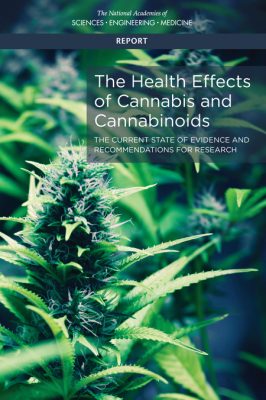National Academy of Sciences, Engineering and Medicine Issues Report on the Health Effects of Cannabis
 In early 2017, the National Academy of Sciences, Engineering, and Medicine issued its first comprehensive report on cannabis since 1999. Shifting public opinion over the past few decades has led to 28 states and the District of Columbia legalizing medical uses of marijuana, and eight states and DC legalizing recreational marijuana use. The Health Effects of Cannabis and Cannabinoids: Current State of Evidence and Recommendations for Research is intended to address the lack of accepted standards to guide individuals in deciding whether and how to use cannabis safely. In addition to summarizing recent health-related findings on cannabis, the report also offers recommendations to guide future research.
In early 2017, the National Academy of Sciences, Engineering, and Medicine issued its first comprehensive report on cannabis since 1999. Shifting public opinion over the past few decades has led to 28 states and the District of Columbia legalizing medical uses of marijuana, and eight states and DC legalizing recreational marijuana use. The Health Effects of Cannabis and Cannabinoids: Current State of Evidence and Recommendations for Research is intended to address the lack of accepted standards to guide individuals in deciding whether and how to use cannabis safely. In addition to summarizing recent health-related findings on cannabis, the report also offers recommendations to guide future research.
The report shares findings about possible therapeutic benefits to cannabis use as well as health impacts relating to areas such as cancer, respiratory disease, immunity, pre- and post-natal health.
There were several notable findings with regard to mental health. The committee that issued the report found substantial evidence of a statistical association between cannabis use and the development of schizophrenia or other psychoses, with the highest risk among the most frequent users.
The committee also found moderate evidence of a link between cannabis use and increased symptoms of mania and hypomania in people with bipolar disorder who use cannabis regularly. The report also describes moderate evidence of an association between heavy cannabis use and increased suicidal ideation and suicide attempts.
There was also moderate evidence that regular cannabis use is linked to social anxiety disorder.
The report described factors that may lead to problem cannabis use. The committee found substantial evidence that being male, smoking cigarettes, and beginning cannabis use at an earlier age are risk factors for developing problem cannabis use.
There was moderate evidence of a link between cannabis use and the development of a substance dependence or substance abuse disorder for substances including alcohol, tobacco, and other illicit drugs.
In the realm of psychosocial functioning, the committee found moderate evidence that acute cannabis use is associated with impairment in the cognitive domains of learning, memory, and attention.
The strongest findings with regard to beneficial effects of marijuana were that cannabis can treat chronic pain in adults, and that oral cannabinoids can reduce chemotherapy-induced nausea and vomiting and improve multiple sclerosis spasticity symptoms. There was also moderate evidence that cannabinoids (particularly an extract called nabiximols) can improve short-term sleep outcomes in people with a variety of ailments. Some of the beneficial effects of marijuana have been linked to the cannabidiol compound, as opposed to the THC in marijuana, which causes the psychoactive effects of the drug.
Editor’s Note: The link between cannabis use and psychosis risk is strong, and reason enough to avoid marijuana use. A common variant of the COMT gene that influences dopamine metabolism increases this risk in young users. The more efficient val-val allele of COMT increases risk of psychosis by depleting dopamine in the prefrontal cortex.

